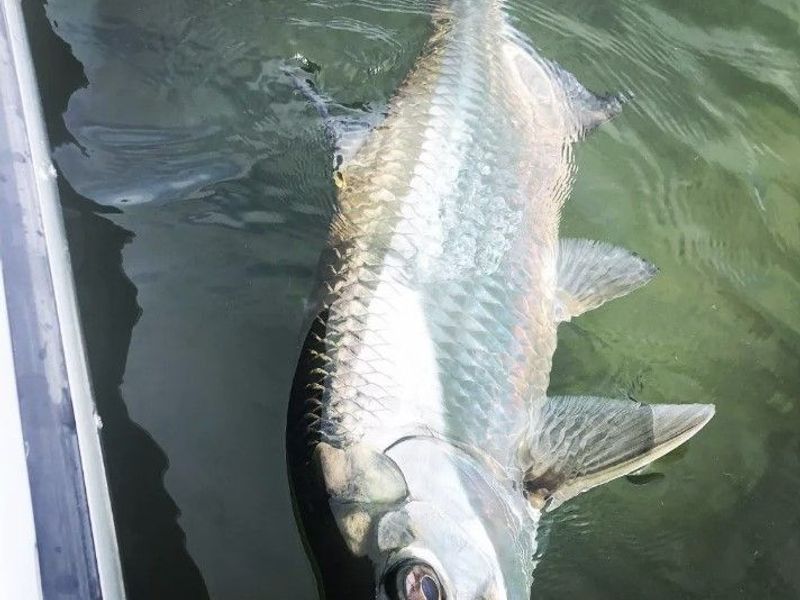Tarpon

Species Details
Megalops Atlanticus
Megalopidae
Elopiformes
Inshore, Flats, Backcountry
25 - 63 lbs.
48" - 96"
What is the Tarpon Fish?
The tarpon fish is a large, carnivorous saltwater fish with distinct large flat scales and a large lower jaw. Known for jumping several feet out of the water while swimming up to 35 mph, the tarpon is a sought-after fish in Florida.
Tarpon (Megalops Atlanticus)
A giant 6-foot Tarpon jumping several feet out of the water is a sight few anglers will ever forget! This bucket list game fish migrates between the Florida Keys, Costa Rica and the Florida Panhandle. The Florida Keys is widely thought of as the tarpon fishing capital of the world.
Florida Bay is a prime location, particularly in the deeper moats around some of the smaller keys and the channels that cut through the mud and grass flats. Tarpon frequent the Atlantic and Gulf "strips," the edges of flats around Islamorada, Marathon, and Key West. The same can be said for Key West Harbor.
Tarpons are classified into two species: M. atlanticus (Atlantic Ocean tarpon) and M. atlanticus cyprinoides (Indo-Pacific tarpon). Atlantic Tarpon can be found along the western Atlantic coast from Virginia to Brazil, as well as in the Caribbean and along the Gulf of Mexico coast.

Tarpon Description and Typical Size
Tarpon have thin bodies covered with large flat scales. One of its more recognizable characteristics is its large lower jaw and mouth points upward. They are shimmery silver with blue-grey or greenish backs and dark fins and tails. The scales on top of the Tarpon body are darker than that underneath. This color makes it difficult for predators to see the fish when viewed from above or below. The tail has a deep fork, and the dorsal fin is elongated and thin.
Adult Tarpon can grow up to about 8 feet long and weigh up to 280 pounds, but the more common size is 4 feet and 80 - 100 pounds. Their lifespan can be up to 50 years or more.
Interesting Facts
- Tarpon are known for their acrobatics and can jump 10 feet out of the water and swim up to 35 mph.
- They are close relatives of Skipjack and Ladyfish.
- Although edible, people rarely eat them because of their small, hard-to-clean bones.
- Tarpon has been around for a long time - 125 million years kind of time!
- Tarpon are capable of filling themselves with air. This gives it a predatory advantage when oxygen levels in the water are low.
Diet
Tarpon are strictly carnivorous; they hunt mid-water bait fish, both small fish and larger fish they swallow whole.
Spawning
Tarpon spawn offshore in warm, secluded areas, usually in late spring to late summer and with a full moon or new moon cycle.
The sperm and egg are all released into the water in a process referred to as broadcast spawning. The female tarpons will release up to 12 million eggs at a time. Once the eggs are fertilized, they float on top of the water. The eggs look like transparent ribbons, which make it difficult for predators to notice. The eggs will absorb the nutrients in the water through the skin.
After hatching, they enter the juvenile stage, remaining in the shallow water until they have developed into an adult.
Where to Find Tarpon Fish?

Tarpon live in a variety of habitats. They mainly occupy saltwater but also range in the brackish water of rivers like Crystal River. They are primarily found in shallow coastal waters and estuaries, but not unusual if they appear in the open ocean close to coral reefs.
Tarpon can gulp air at the surface when they are in an environment that doesn't provide enough oxygen.
You will find them as far north as New England and occasionally in Nova Scotia, Canada in the summer months. Being migratory fish, you will find them in Southern Florida or Central America in the winter months. Their largest concentration is in South Florida and the Gulf of Mexico.
Some of the best places to find Tarpon include the Florida Keys, especially Islamorada, Marathon, Key West and the Everglades National Park. Miami is another great spot, especially Key Biscayne, Biscayne Bay, and Biscayne National Park. There are a number of other great places such as Boca Grande near Fort Myers and North thru Tampa Bay to Tarpon Springs and Crystal River. Don't forget Florida's Atlantic Ocean side with St. Augustine, Florida, St. Simons Island in Georgia, and San Juan Puerto Rico.
A Few Related Tarpon Fishing Articles:
Learn the Best Tarpon Fishing Spots
Fishing Techniques - How to Catch Tarpon
Although Tarpon can reach up to 280 pounds, heavy tackle is not required. A 5000 to 7000-size spinning reel paired with a medium-weight rod is a high multi-purpose tackle for Tarpon fishing that will be sufficient. The reel should be corrosive-resistant and have a smooth and robust drag to tame the fish quickly. When fishing tarpon, shrimp, pinfish, mullet, and crabs are the best live bait. Stake out above tarpon-holding areas and drift your live bait down to the fish. Hook crabs in the shell's corner and baitfish through the mouth.
Fly fishing the shallow flats is exciting. Watching a school of the larger fish turn towards the boat, knowing you are one perfect cast from landing a giant tarpon, is exhilarating. An angler armed with a 10wt rod and a perfect cast leads the school of fish, stripping like mad to lure the large Tarpon. A few flies to try while fly fishing includes the Black Death, Purple People Eater, White Lightning, Tarpon Shrimp, Coker Smoker, and the Tarpon Toad.
Their athleticism is one of the most fantastic attractions of Tarpon fishing. When the fish is hooked, it will use its muscular build and incredible speed to jump out of the water. Be careful; often, these jumps help the fish remove the hook.
There is nothing like a successful and enjoyable tarpon fishing trip on a fishing charter. Fishing charters are the best way to ensure that you have a successful and enjoyable tarpon fishing trip. You'll have the chance to explore some of the most beautiful locations in the world not only because you will be able to access the best equipment and professional guidance, but also because you will have the latest fishing report, tarpon migration, and a guide to understand where the large fish are roaming.
Can you Eat Tarpon?
While Tarpon fish are thrilling to reel in, many people wonder if tarpon is good to eat. The short answer is that while you technically can eat tarpon, it's not recommended for several reasons.
Firstly, tarpon has high levels of mercury, which can be harmful in large quantities. Secondly, their flesh tends to be tough and full of bones, making it challenging to prepare and enjoy as a meal. Additionally, most anglers practice catch-and-release with tarpon as they are highly sought after for sport rather than food. While it may be possible to eat tarpon fish if you choose to do so, it's not recommended due to the high levels of mercury present in their flesh and the difficulty in preparing them for consumption.
If you do want to test the waters and try eating tarpon, you will find a white, flaky texture with a mild taste and oily flavor. It is advised to only consume tarpon caught in clean waters to avoid any potential health risks. When preparing tarpon for consumption, it is best to bake or grill it and avoid consuming it raw. Ultimately, whether or not to eat tarpon is a personal choice, but those who choose to do so should ensure that it is properly cooked and comes from a safe source.
Tarpon History
A review of Tarpon history reveals that these prehistoric fish that have been around for over 100 million years have received much attention from scientists in Florida, especially over the last several years. To determine the survival rate after a long battle, researchers at the Florida Marine Research Institute track and release individual tarpon to determine how well they survive the battle.
There have been a few rare cases in which tarpon has been found in northern locations like Nova Scotia, Canada. Female tarpons can grow to over 300 pounds and can reach almost 8 feet in length. A female tarpon can live for over fifty years, and a smaller male can live for up to thirty years. In an aquarium, the oldest tarpon in captivity died at 63 years of age after living for over fifty years.
Tarpons are extremely slow growers. Juvenile tarpon does not reach sexual maturity until seven, and they can reach sexual maturity as late as thirteen years old. Most tarpon fishing is done right close to shore; the tarpon spawns offshore when the tides are at the highest on major moons when they are at their strongest. Tarpon spawns during the month of April through July. The significant moons are when other fish move into shallow waters while others are moving out to spawn.
For all these reasons, it is very easy to see why it is so important to release each and every tarpon as carefully as possible. For example, a 100-pound tarpon is between 13 and 16 years old. One female tarpon can lay as many as 12 million eggs.
About the Tarpon Population
Tarpons are one of the most sought-after fish in the world, and their population is dwindling.
Tarpons are a threatened species and are considered an endangered species by the International Union for Conservation of Nature (IUCN). They're also popular game fish for sport fishing and commercial purposes.







